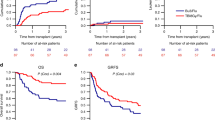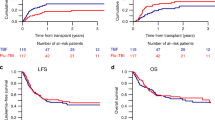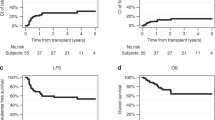Abstract
Relapse after transplant for malignant lymphomas remains the main cause of treatment failure. Most conditioning regimens contain total body irradiation (TBI). We investigated the toxicity and efficacy of an intensified chemotherapy conditioning regimen without TBI in patients with relapsed or high-risk malignant lymphoma who had received prior radiation therapy and were therefore not eligible for TBI. Twenty patients with a median age of 38 (18–56) and relapsed or high-risk malignant non-Hodgkin’s lymphoma (NHL, n = 16) or Hodgkin’s disease (HD, n = 4) underwent high-dose chemotherapy consisting of busulfan (16 mg/kg), cyclophosphamide (120 mg/kg) and etoposide 30 mg/kg (n = 8) or 45 mg/kg (n = 12) followed by peripheral stem cell support (n = 14), autologous bone marrow (n = 3), allogeneic (n = 2) or syngeneic (n = 1) transplantation. All but two had chemosensitive disease before high-dose chemotherapy. The main toxicity – according to the Bearman score – was mucositis II in 18 (90%) patients; five patients (25%) suffered a grade I hepatic toxicity. GI toxicity I occurred in three (15%) and renal toxicity I in two patients (10%). Sixty percent of the patients developed transient dermatitis with erythema and three of them (15%) had skin desquamation; one patient experienced asymptomatic pancreatitis. Toxicity was slightly higher in patients treated with 45 mg/kg etoposide. One patient (5%) died of treatment-related veno-occlusive disease. After a median follow-up of 50 months (24–84) the disease-free and overall survival were 50% and 55%. One of the nine relapsing patients developed secondary AML 18 months after transplant. High-dose busulfan, cyclophosphamide and etoposide is an effective regimen resulting in long-term disease-free survival in 50% of patients with relapsed malignant lymphoma and prior radiation therapy. The toxicity is moderate with a low treatment-related mortality (5%).
This is a preview of subscription content, access via your institution
Access options
Subscribe to this journal
Receive 12 print issues and online access
$259.00 per year
only $21.58 per issue
Buy this article
- Purchase on Springer Link
- Instant access to full article PDF
Prices may be subject to local taxes which are calculated during checkout
Similar content being viewed by others
Author information
Authors and Affiliations
Rights and permissions
About this article
Cite this article
Kröger, N., Hoffknecht, M., Hänel, M. et al. Busulfan, cyclophosphamide and etoposide as high-dose conditioning therapy in patients with malignant lymphoma and prior dose-limiting radiation therapy. Bone Marrow Transplant 21, 1171–1175 (1998). https://doi.org/10.1038/sj.bmt.1701245
Received:
Accepted:
Published:
Issue Date:
DOI: https://doi.org/10.1038/sj.bmt.1701245
Keywords
This article is cited by
-
Autologous hematopoietic cell transplantation using dose-reduced intravenous busulfan, melphalan, and thiotepa for high-risk or relapsed lymphomas
Bone Marrow Transplantation (2019)
-
Feasibility of BU, CY and etoposide (BUCYE), and auto-SCT in patients with newly diagnosed primary CNS lymphoma: a single-center experience
Bone Marrow Transplantation (2011)
-
Autologous transplantation for relapsed non-Hodgkin's lymphoma using intravenous busulfan and cyclophosphamide as conditioning regimen: a single center experience
Bone Marrow Transplantation (2009)
-
Intensive conditioning regimen of etoposide (VP-16), cyclophosphamide and carmustine (VCB) followed by autologous hematopoietic stem cell transplantation for relapsed and refractory Hodgkin's lymphoma
Bone Marrow Transplantation (2008)
-
Multicenter study of intravenous busulfan, cyclophosphamide, and etoposide (i.v. Bu/Cy/E) as conditioning regimen for autologous stem cell transplantation in patients with non-Hodgkin's lymphoma
Bone Marrow Transplantation (2007)



